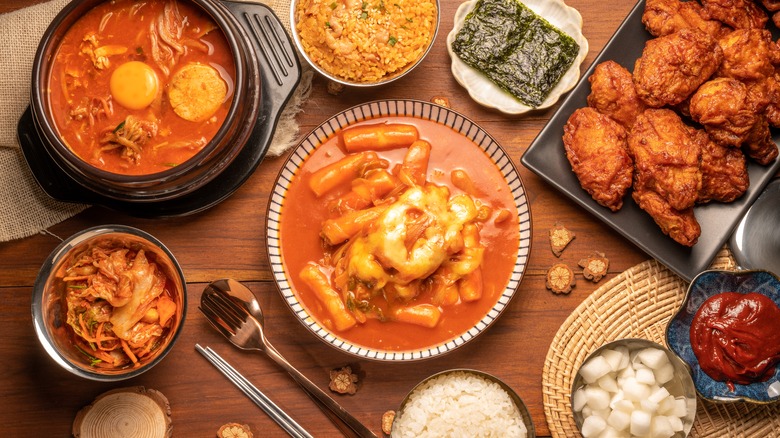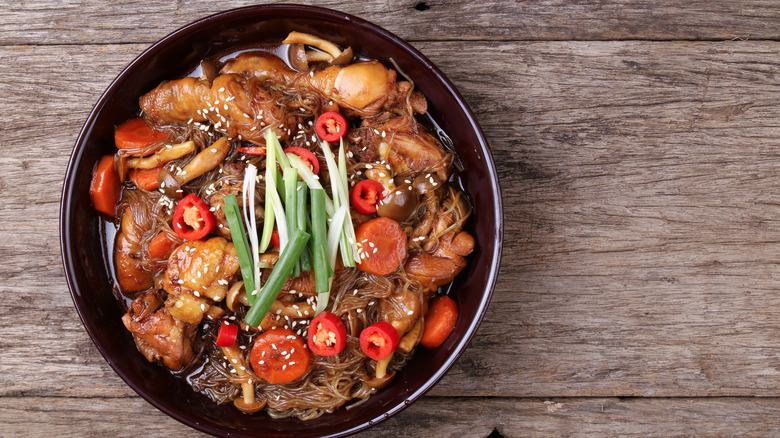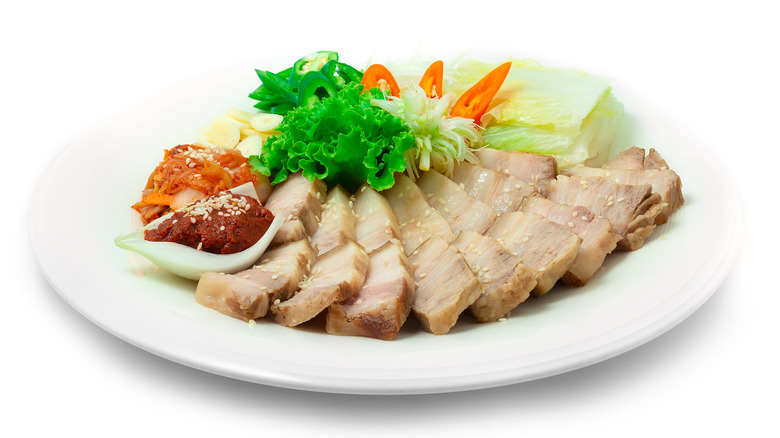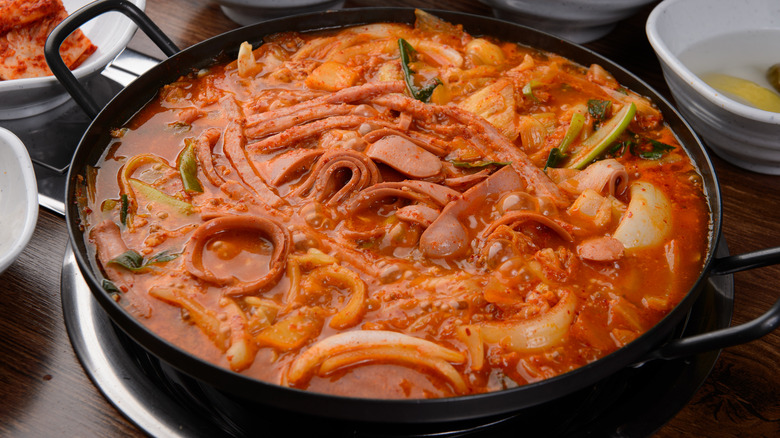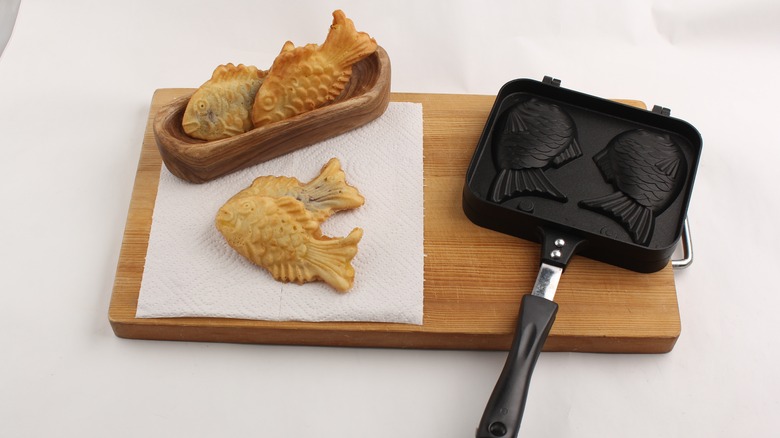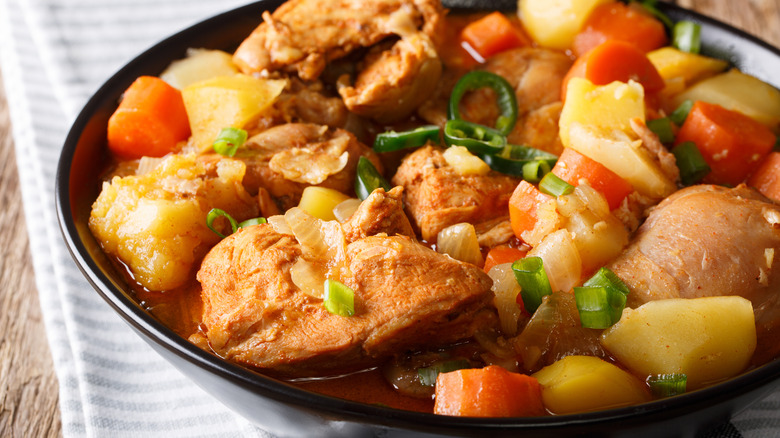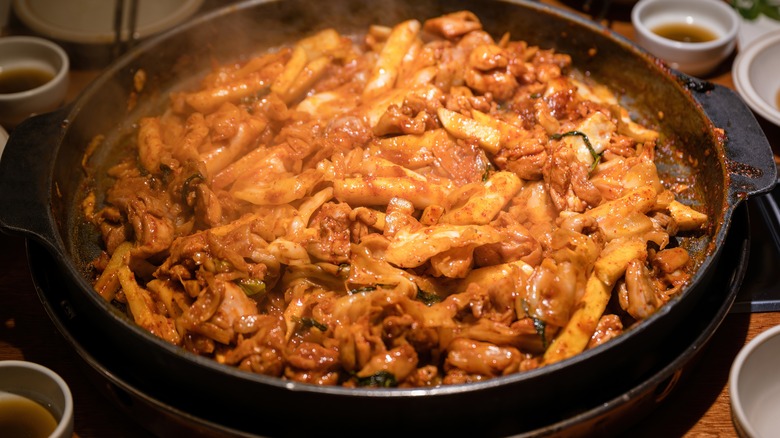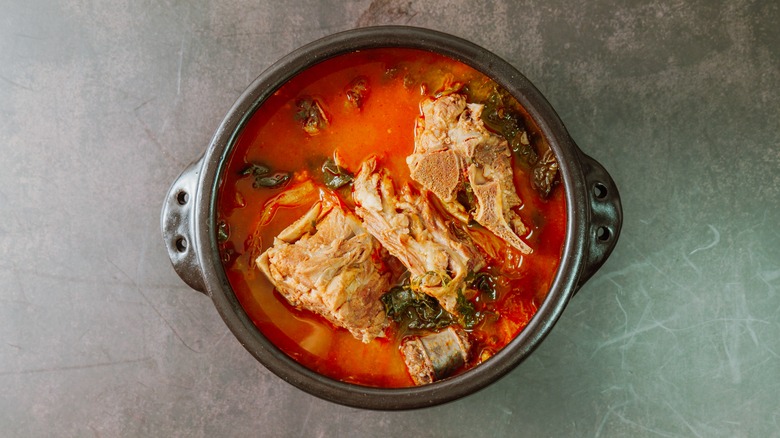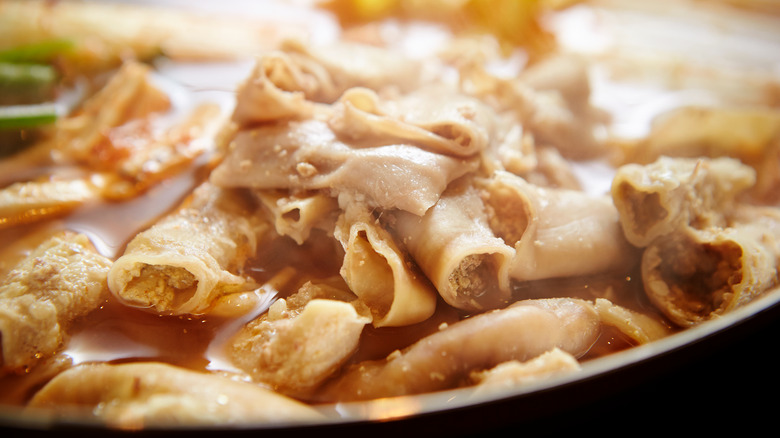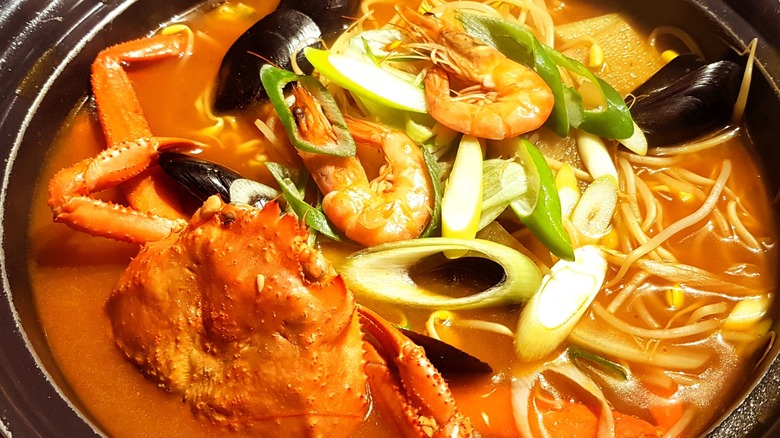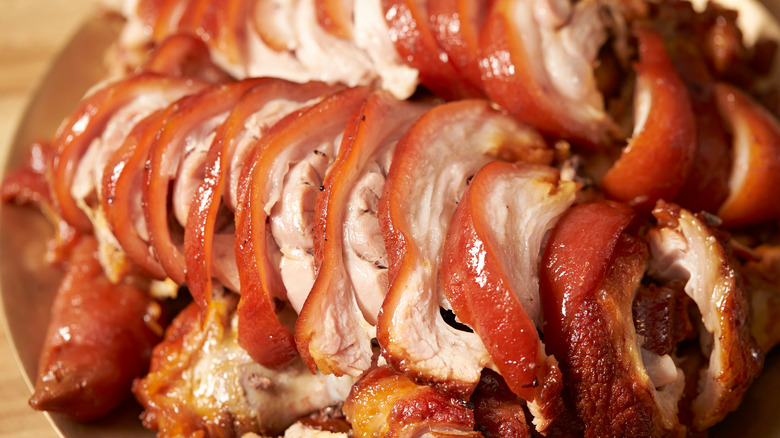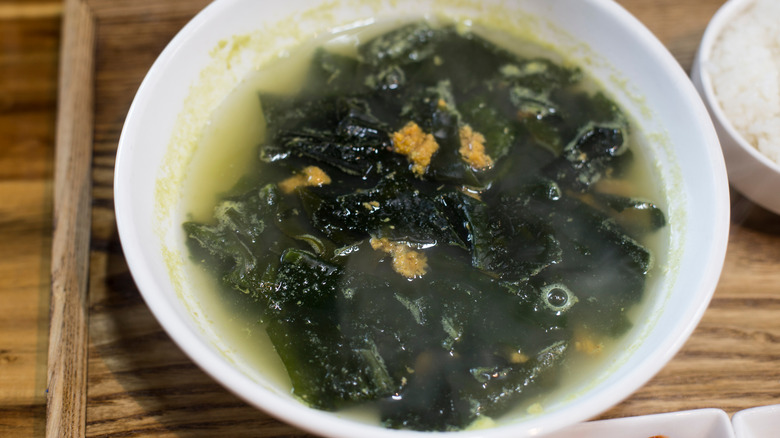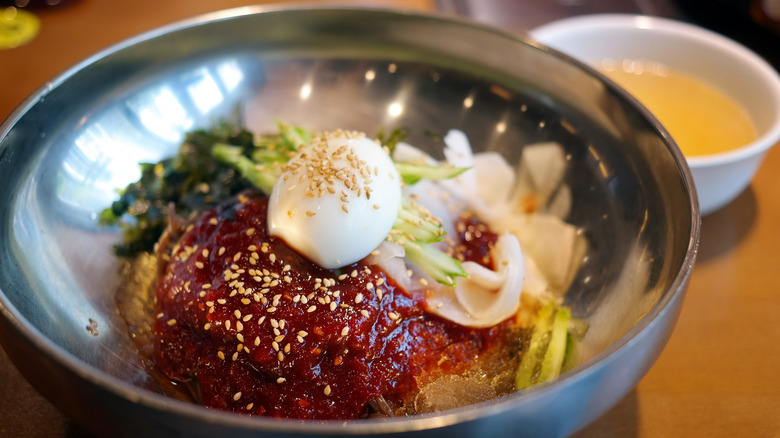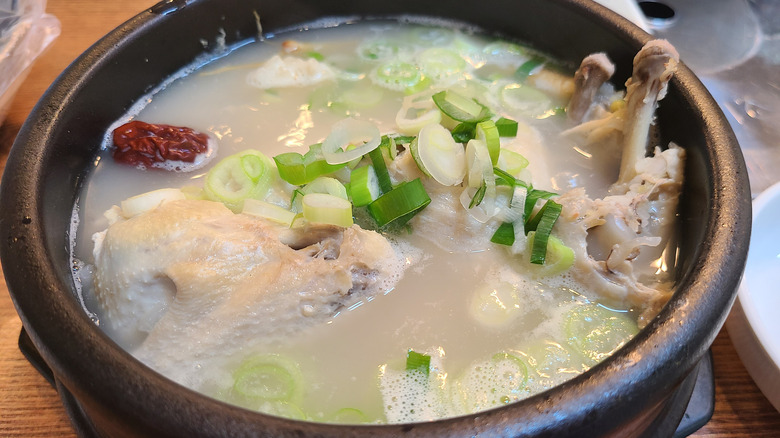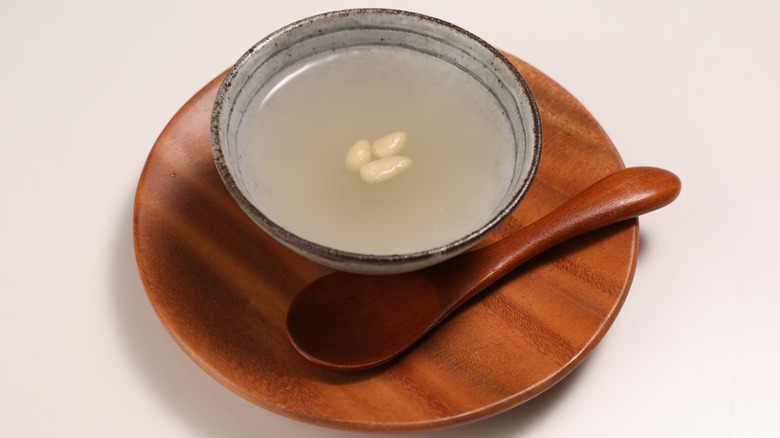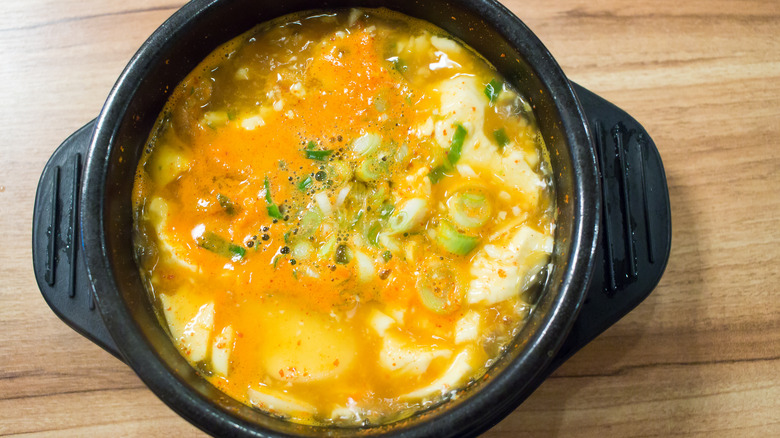Korean Dishes You Didn't Know You Should Be Ordering
A few decades back, Korean markets and restaurants weren't all that common, except perhaps in areas around army bases. The American military, after all, has long had a presence in South Korea, and by the early 1990s around 100,000 Korean women had married service members and immigrated to the U.S (via National Association of Korean Americans). A decade or so into the 21st century, though, a new (to us) phenomenon called K-pop started making its way to our shores. By 2012, the inescapable hit "Gangnam Style" was taking over the internet, but K-pop got an even bigger boost when the genre was showcased at the 2018 Seoul Olympics. Well, once Korean pop music started trending, Korean food followed close behind, per Forbes. Now, you'd be hard put to find a hipster bistro not offering Korean-style fried chicken with gochujang-spiced tater tots sauced in kimchi mayo.
By now you may be buying your bulgogi at Costco and making your own bibimbap, and perhaps even accompanying your "Squid Game" binges with homemade dalgona candy and whipped coffee. If you really want to explore what Korean cuisine has to offer, though, you'll need to seek a bit further afield. The following dishes are more likely to be found in authentic Korean restaurants. You could also try making them at home, but you will probably need to seek out a Korean market or purchase some of the ingredients online.
Andong jjimdak
Jjimdak, also known as Andong jjimdak, is a chicken dish named after the Korean city that's been referred to as both "the most Korean place in Korea" and "the capital of Korean spirit," (via The Soul of Seoul). The dish does, in fact, originate in Andong as the name implies, although it's now popular all over the country. It seems that in the 1970s, chicken really started to take off in Korea, and both rotisserie and fried chicken restaurants started popping up all over (via Food Worth Writing For). Chicken vendors in Andong decided they wanted to create their own regional specialty, and they came up with jjimdak (via Korea.net).
To make jjimdak, the chicken is first boiled, then simmered in a salty-sweet galbi sauce that is used for barbecue. Galbi is soy sauce based and sweetened — in some cases, by using fruit such as pears (via Taste Atlas). Jjimdak is also spicy thanks to plenty of chili peppers, and it also includes a selection of vegetables. The jjimdak served at Chicago's Ssyal contains bok choy, carrots, green onions, mushrooms, onions, and potatoes, while spinach is a popular addition elsewhere. Just before the jjimdak finishes cooking, glass noodles are added to bulk up the dish and absorb all of the tasty sauce.
Bossam
During ancient times, the Korean word bossam referred to a practice by which a person (often a widow) was wrapped up in a blanket or sack and coerced into marriage after this enforced closeness (via K-Odyssey). While the idea sounds quite horrific, in actual fact, it was often the only way widows were permitted to re-marry and was done with the sub rosa consent of the couple involved. Today, however, bossam refers to a much happier union, that of pork and cabbage.
Funny how comfort food from one part of the world can closely resemble dishes from another country thousands of miles away; in Poland, just as in Korea, pork-stuffed cabbage is a popular dish. Unlike the pork in Polish golabki, however, the pork in bossam is not chopped or ground, nor is it mixed with rice and topped with tomato sauce. Instead, bossam is typically made from boiled or steamed sliced pork belly. At Mr. Bossam in LA's Koreatown, you can get the dish made from hog jowls or pork feet, and there's also the option of bossam made from grilled meat. Whatever type you order it comes on a bed of noodles, combining meat, cabbage, and starch in this filling and somewhat balanced meal.
Budae jjigae
Budae jjigae could be considered the original Korean-American fusion cuisine. The reason for this dish — and for its name, which translates to "army base stew" — is a not-as-forgotten-as-we'd-like conflict known as the Korean War. The original ingredients, which included American-made items such as mac and cheese, baked beans, hot dogs, Spam, and various other forms of canned mystery meat, managed to "fall off the back of a truck" somewhere between the military commissaries and the black markets that tended to thrive on the outskirts of the bases.
As conditions in Korea improved after the war, budae jjigae came to include newly available Korean foods such as noodles, dumplings, and fish cakes, and in time some of the processed meats used in the stew came to be domestically produced as well. Today, restaurants specializing in budae jjigae can be found all over Korea, but they've yet to catch on to any great extent in the U.S. One exception is Bally Budaejjigae in Suwanee, Georgia. This restaurant makes its eponymous dish, available in single and family-sized servings, with bean sprouts, ground beef, kimchi, mushrooms, rice cakes, sausages, Spam, "secret spicy broth," and optional add-ins including tofu, ramen noodles, and American cheese.
Bungeoppang
Bungeoppang, a popular Korean street snack, is a type of stuffed waffle or pancake shaped like a fish. The fact that this dish bears a strong resemblance to Japanese taiyaki is no coincidence. Taiyaki, a filled cake shaped like the red sea bream that's seen as a symbol of good fortune in Japan, was invented in 1909 (via Food in Japan). The very next year, Korea faced a significant hardship –- the country was annexed by the Empire of Japan, and would not regain its freedom until WWII was over (via History). While a sweet treat is no consolation whatsoever for decades of oppression, there's little doubt that taiyaki was introduced to Korea during that time period. Koreans, however, renamed these fish-shaped cakes bungeoppang, which means carp bread.
While traditional bungeoppang (and taiyaki) are filled with sweet red bean paste, they now come in a wide variety of flavors such as chocolate and custard to suit today's tastes. There's also a variation called ah-boong where the fish waffle is filled with or used to top a dish of soft-serve ice cream. If you're feeling ambitious, you can even buy a fish-shaped waffle maker to cook bungeoppang at home.
Dakdoritang/Dakbokkeumtang
Dakdoritang is a chicken stew cooked in a fiery red sauce made with gochujang, soy sauce, and garlic. The stew typically includes potatoes and other vegetables such as carrots and onions. It also seems to date from the Japanese colonial period in Korea, and Taste Atlas explains that part of its name is thought to have come from the Japanese language: dak is the Korean word for chicken, while tori is Japanese for bird or poultry. Meanwhile, tang is Korean for a type of soup.
Even though dakdoritang is found under that moniker on countless restaurant menus, many Koreans prefer to call it by another name: dakbokkeumtang. According to one Redditor, many older Koreans (including the user's grandmother) feel that it is a more suitable name for the dish. Bokkeum means "stir-fried," and its name translates to stirred chicken stew.
This is basically the equivalent of Americans renaming sauerkraut as liberty cabbage in WWI and French fries as freedom fries during the Gulf War. Whether this name change is necessary or not is a matter of some dispute, as there are other Koreans who feel that dakdoritang does not reflect any Japanese influence. Linguistic politics aside, the words dakdoritang and dakbokkeumtang both refer to the same recipe. More importantly, it's delicious no matter what you call it.
Dakgalbi
As per the previous slide, we've already established that dak means chicken. We've also discussed the fact that galbi refers to a type of Korean barbecue. Well, put both words together and what do you have? You guessed it, barbecued chicken. Galbi (or sometimes kalbi) is usually assumed to refer to barbecued beef ribs since this is the most well-known version (via Taste Atlas). Dak galbi, however, is also pretty popular, as it should be.
The sauce itself is often made of sweetened soy sauce seasoned with garlic and may contain additional ingredients such as sesame oil, rice wine, or gochujang. Instead of being applied after the chicken is cooked as is often the case with American barbecue sauce, it is typically used as a marinade. At some restaurants, including Mapo Galbi in LA's Koreatown, dak galbi is served in the form of a stir-fry with rice cakes, sweet potatoes, and a leafy green herb called ggaenip. They'll even top it off with melted cheese if you wish. Sure, it's not your typical barbecue chicken, but cheesy Korean stir-fried barbecue is poised to become our new favorite.
Gamjatang
The idea of nose-to-tail eating, while popularized by 21st-century foodies, predates the trendy hashtag version by several millennia. After all, it was darn hard to take down a woolly mammoth without having it return the favor, so you weren't about to throw away a single bit of that hard-won beast. One Korean dish that seems to epitomize the zero-waste philosophy is gamjatang, a soup made out of pork backbones. According to The Korea Times, the dish was created in the city of Incheon by dockworkers looking for something dirt-cheap and filling. This was poverty cuisine at its finest -– and so tasty it was soon picked up by restaurateurs. So popular has this dish since become, that gamjatang-flavored ramen is now a thing, as well.
So how do you make spine soup? Assuming you can get a hold of this often overlooked pig part, you simmer it in broth with potatoes and season it with chilis, garlic, bean paste, and wild sesame seeds. You can also garnish it with sesame leaves and chives. Eating the spines might be tricky, but chopsticks help separate the cooked pork while the potatoes fill you up even if you don't get all of the meat.
Gopchang
Intestines for dinner? Ugh, how offal! Or is it? The thing about intestines, as with just about any other foodstuff, is that it's all in how you cook them. Stuff them with ground meat, twist them into a tube, and grill or fry them? That's not the wurst idea anyone has ever had, and this method of sausage-making is not unknown in Korea. Korean cooks, however, have come up with another way of making this unpopular organ pretty darn palatable by turning intestines into gopchang.
Gopchang, which is made from the small intestines of either cattle or pigs, can be grilled, stir-fried, or stewed in a spicy hot pot. While this dish tends to be chewy and can also have a lot of fat, it's actually quite tasty and doesn't have the bitter flavor often associated with other organ meats. Gopchang is not only nutritious but it is a popular meal to have with drinks, as it's said to help you metabolize the alcohol you're consuming.
Haejangguk
Blogs about Korea often discuss the nation's drinking culture, but the country isn't actually among the heaviest drinkers. Per World Population Review's list of alcohol consumption per capita, Korea comes in 56th place. Its drinking isn't even high by Asian standards, and Thailand, Japan, and Laos all consume more. (For sake of comparison, the U.S. ranks 38th, while Latvia holds the top spot.) Still, most countries, no matter where they rank on the list of biggest boozers, not only have their own national drink –- Korea's is soju, a low-ABV clear spirit –- but also a dish typically eaten after a night of overindulging. In Korea, people eat haejangguk, which basically translates as a detoxify soup (via Korea JoongAng Daily).
There is no one widely accepted haejangguk recipe, as they tend to vary from region to region and cook to cook. According to Fine Dining Lovers, the soup can be made with beef or seafood broth and may contain ingredients such as bean sprouts, seaweed, eggs, rice, cabbage, and cow's blood. The one element most recipes have in common, though, is that they tend to be spicy. The heat from the chilis is meant to help speed up the body's metabolism and drive out the booze demons.
Jokbal
In the U.S., we typically eat high on the hog –- quite literally, as some of our preferred pork parts include chops, loins, and baby back ribs, all from the top part of the pig. In Korea, however, cooks embrace the entire swine. While pork belly may be the most popular part, they're not afraid to go a little lower down — in fact, all the way to the bottom of the pig, as in jokbal, a dish of spiced sliced pig's feet (via Eater).
Jokbal is typically made from trotters (some connoisseurs favor the front ones), but often includes some of the hocks, as well. To make this dish, the pork parts are boiled in a sauce of rice wine, soy sauce, garlic, and ginger. The pig trotters are then cooled, chopped up, wrapped in lettuce or cabbage leaves, and eaten with kimchi, garlic, chilis, and a fermented shrimp sauce called saeujeot. While the best reason to eat jokbal is that it tastes great, it's also popular due to the fact that the collagen content has alleged (though unproven) anti-aging properties. Jokbal is also pretty nutritious, something that makes it a favorite with breastfeeding moms, according to a 2017 study published in the Korean Journal of Pediatrics.
Miyeokguk
While many Koreans today celebrate their birthdays with cake –- and some, no doubt, with soju as well -– there is another dish that is typically eaten on this occasion: a seaweed soup known as miyeokguk. Birthday miyeokguk is a common tradition because the practice honors the celebrant's mom who may have eaten the stuff for an entire month (or more) in order to facilitate an easier birth and stimulate milk production (via Korea.net). This bit of folk wisdom dates back over 1,000 years and may have been inspired by the sight of mama whales eating seaweed after calving.
Dried seaweed may be the most important ingredient in miyeokguk, but it's not the only one. The soup is usually flavored with soy sauce, garlic, and sesame oil, and it may also include meat or seafood. Miyeokguk, if prepared properly, can be tasty as well as nutritious, but it's not the sort of dish you should eat all the time even if you are pregnant or a nursing mother. The soup contains extremely high levels of iodine, and Korea Biodemical Review reports that eating large amounts of it may be a contributing factor to the high rate of thyroid cancer in Korea, particularly among women.
Naengmyeon
While many of the Korean dishes we're familiar with come from South Korea, the noodle dish known as naengmyeon is of North Korean origin. There are actually two different types of naengmyeon: mulnaengmyeon, which comes from Pyongyang, and bibimnaengmyeon, a specialty of Hamhung Province. The noodles from the former are made with buckwheat, while the latter's are made of corn, but both ingredients testify to the fact that the colder northern latitudes are less conducive to rice growing than in the south.
The two types of naengmyeon are prepared in different ways, as The Korea Times reports. Mulnaengmyeon noodles are served in an icy-cold beef or chicken broth topped with some combination of boiled eggs, cucumbers, kimchi radishes, sliced pears, and sliced beef or pork. Bibimnaengmyeon, while also served cold, does not come with broth. This version is also much spicier than the fairly mild mulnaengmyeon, as it tends to be liberally laced with gochujang. This dish also typically includes boiled eggs, kimchi radishes, and is often topped with sliced fish.
Samgyetang
Is chicken soup the universal cure-all? Apparently, its reputation as a tastier alternative to penicillin extends to Korea, as well. Samgyetang, a Korean remedy, is doubly healthy since it is made with chicken and ginseng roots. The soup is credited with the ability to perform miracles such as reducing stress levels, promoting weight loss, improving digestion, and helping to cure a wide variety of illnesses (via The Chosunilbo). Interestingly enough, it's more likely to be eaten during summer than winter. While it might seem odd to us, eating a hot dish can actually help the body cool down, and samgyetang is also said to stimulate the appetite on those days when it's too hot to eat a proper meal.
To make samgyetang, you take a whole chicken and stuff it with chestnuts, rice, and Korean dates, then boil it in a broth made from ginseng and flavored with garlic and green onions. In some cases, the broth also contains medicinal ingredients such as gingko. As samgyetang is a pretty labor-intensive recipe, it's not something that many people prepare at home. Instead, there are numerous restaurants that specialize in this dish. They serve it up by the bowlful, accompanied by side dishes such as gizzards sauteed in garlic, and often with a free shot of ginseng-based booze called insangju for additional health benefits (some of them said to be of the aphrodisiac variety).
Sikhye
Rice is not just a staple food in Korea, but also the main ingredient in over 200 different types of Korean booze, including the ever-popular soju. It is also used to make a popular non-alcoholic beverage known as sikhye. The drink's flavor is somewhat sweet, but a distinctive malty taste from the barley malt content is also noticeable. Besides rice and malt, Taste Atlas notes that sikhye is made with sugar and sometimes pine nuts. There is, however, a more savory version known in Andong that is flavored with red peppers, ginger, and radishes (via 196 Flavors).
Despite their differences, both types of sikhye are served as an after-dinner drink, although the former has more of a dessert-like quality to it. Both are said to aid digestion, as the rice provides fiber while the fermentation that may play a role in the beverage production helps provide good gut bacteria. Sikhye is also often served as a holiday drink for New Year's Day and other festivals and celebrations.
Sundubu jjigae
While many Korean entrees are quite meaty, there are a few dishes that even vegetarians can eat. One such item is sundubu jjigae, a stew made with tofu. Sundubu, or soon dubu (transliteration conventions vary), refers to a type of soft uncurdled tofu, while sundubu jjigae is a hotpot stew made with that type of tofu. While the dish's star ingredient is the tofu from which it takes its name, the stew also contains various types of vegetables, seasonings, and in many cases, meat or seafood. Although it is not always vegetarian, it can be made that way.
Several different restaurants in Los Angeles' Koreatown specialize in sundubu preparations. Beverly Soon Tofu offers sundubu jjigae in several different varieties, although only two options are likely to be vegetarian: vegetable with mushrooms, onions, radishes, and zucchini and soybean paste with mushrooms. Meanwhile, at BCD Tofu House, a vegetable sundubu jjigae featured on the menu is made with broccoli, mushrooms, onions, and squash, in addition to tofu.
